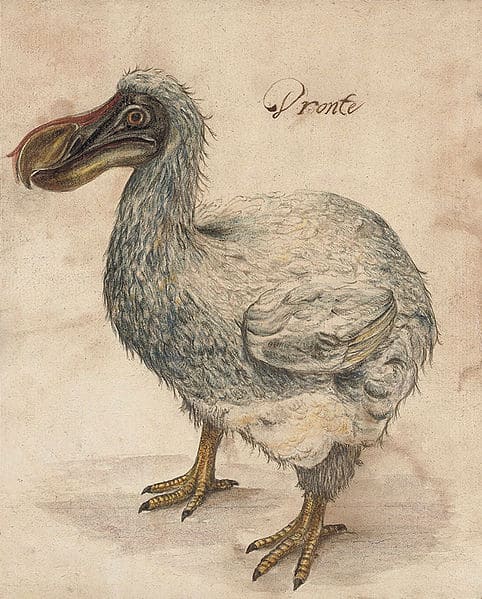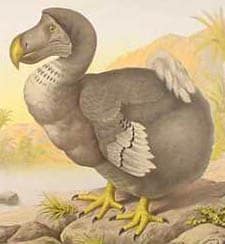Dodo birds are flightless birds that have been extinct for quite some time. Mauritius is their historical home, and they were endemic to the island. This island is about 500 miles east of Madagascar in the Indian Ocean. The dodo bird has been gone for some time, but when exactly did the dodo bird go extinct?
Where were they found and when did dodo birds go extinct? Dodos were found mostly in the forests of Mauritius. When humans found the island, the rapid decline of native ecosystems occurred. Much endemic flora and fauna were lost to quick deforestation and development.
Until the 19th century, because of the scant evidence of their existence, most scientists thought dodos were a myth. However, they were very real. In less than 100 years, though, they were wiped off of the face of the planet.
Their extinction happened swiftly, and until recently, there wasn’t much evidence that they existed. When did the dodo bird go extinct? We’ll go over this and some other interesting facts about the bird.
When Did the Dodo Bird Go Extinct?

Dodo birds went extinct sometime between 1662 and 1690.
©Dutch School, 17th Century – Public Domain
The dodo bird went extinct sometime between 1662 and 1690. The last sighting was in 1662, but it’s believed that unnoticed populations lived for another few decades. It went extinct within a century of being discovered.
Their habitat was swiftly destroyed. Hunters also targeted them, and invasive species took advantage of their evolutionary vulnerability.
It’s believed they evolved to be big and flightless because there were few natural predators for the bird in Mauritius. After the Dutch first encountered the dodo in 1598, it had a target on its back.
Why Did the Dodo Bird Go Extinct?
The dodo bird went extinct due to human activity. Things like deforestation, human settlements, and invasive species are the primary forces behind their demise.
It’s believed that the dodo was centered around one swamp on the island and that it didn’t have a large home range. Because of this, when external threats encroached on their homes, they were easily decimated.
While human predation is rumored to have been an issue, it wasn’t nearly as big of a problem as the one posed by their animals. The animals that humans brought with them excessively preyed on the dodo.
However, dodos did make easy prey for humans because they didn’t know to fear humans. They were easily hunted because of this. This is how the dodo got their reputation for being dumb.
If invasive animals didn’t prey on the dodo, they preyed on their food supply. Some of the invasive animals are macaques, dogs, pigs, cats, and rats.
What Did the Dodo Bird Look Like?

No one is exactly sure what the dodo bird looked like.
©remake of 1626 painting by Roelant Savery – Public Domain
Photography didn’t exist when the dodo went extinct, so the only visual queues we have when determining the bird’s appearance are paintings, drawings, and written descriptions from the 1600s. Due to the dodo bird’s popularity, its likeness is a popular image today, and it’s even an emoji.
Fossil records show that the dodo stood a little over three feet tall. In the 17th century, realistic portrayals of animals were not part of the artistic canon of the time, so any extant drawings and paintings are subject to artistic embellishment. They can’t be relied upon as factual representations.
Generally, it’s shown with a brown-grey coloration accentuated with yellow feet. It had longer tail feathers, a bare neck, a bald head, and a colorful beak. Its thick beak may have been strong enough to bust open coconuts.
This bird also had strong legs to support its big body, and studies of fossilized bones have shown that it most likely was a swift runner. It weighed up to 50 lbs, which is another reason dodos have such substantial legs.
Its beak was likely its primary defense, and its small wings were used defensively in standoffs with other dodos. Fossil records of wings with injuries suggest that the flightless wings still served a purpose.
Chicks grew quickly and obtained adult size in months so they could endure the stormy and lean summers on Mauritius. Females may have lived to be about 17 years old, while males lived to be 21 years old. Males were larger than females.
What Did Dodo Birds Eat?
No one is sure what dodo birds ate, and it’s thought they consumed fruit, crabs, insects, nuts, roots, and other items.
There is a tree called the tambalacoque tree, colloquially known as the dodo tree. That’s because it’s believed their diet was based around this plant.
Fossils have shown that it digested its food with gizzard stones. Scientists think they liked the drier areas of the island, which are mostly found along the coast.
Are Dodo Birds Big Pigeons?

Dodo birds are related to pigeons and doves.
©Anoop / CC BY-SA 2.0, Flickr – License
Yes, in a sense, dodo birds are large pigeons. They could also be considered large doves.
That’s because dodos are a relative of these extant animals. Ancient doves or pigeons ventured across the ocean and found the island. There were minimal predators, so it made a great permanent destination.
Since there was little predation, dodo birds were able to evolve into bigger birds over time. They became flightless because they didn’t leave their small habitat. They also laid their eggs on the ground without a nest or any protective covering, which made them vulnerable.
Dodos are close relatives to the modern pigeon. There are fragments of DNA that have been obtained from dodo remains, and some think that the dodo could be revived. A pigeon would act as the surrogate in this situation, though most think this experiment is unrealistic.
Are There Dodos in Captivity?
No, there are no dodos in captivity. However, various explorers tried to transport live specimens to Europe and Asia. How many were transported is unknown, and we know that not many made it to their destinations alive.
A viable captive population was not established before their extinction. This is because specimens weren’t captured and transported in a conservation effort like they would be today. They were kept more like trophies or exhibits.
The last known live dodo in captivity was in Nagasaki, Japan, in 1647.
The photo featured at the top of this post is © Kit Leong/Shutterstock.com
Thank you for reading! Have some feedback for us? Contact the AZ Animals editorial team.






